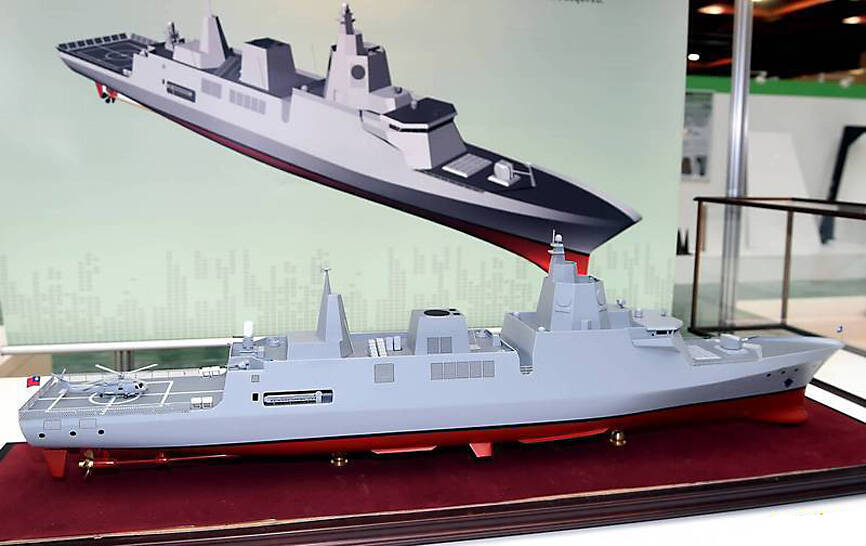The navy has renewed the initiative for building next-generation guided missile frigates, Ministry of National Defense bidding notices showed.
They sought designs for a frigate’s hull structure, command and control, radar, propulsion and weapon systems, among others, a request for information on procurement posted on the government’s public information Web site on Tuesday last week showed.
The next-generation guided missile frigate was not mentioned by name, but Taiwan has no other frigate programs.

Photo: Taipei Times
The navy had previously obtained a draft for the 6,500-tonne advanced warship, significantly more than the planned 4,500 tonnes.
That meant either the state-run Chungshan Institute of Science and Technology achieved a breakthrough in creating a compact active electronically scanned array (AESA) or the navy gave up on the original concept and returned to the drawing board.
The proposed frigates — meant to serve as the centerpiece of the navy’s surface fleet — faced troubles during its development, as the program had to change requirements and specifications.
The Control Yuan last year released a report saying that the program had been mismanaged, resulting in delays that compromised national defense.
The navy had told the public that the next-generation warship would be equal to and compatible with the Aegis combat system used by the US Navy’s Arleigh Burke-class destroyers.
That advanced warship would have been armed with a domestically-produced battle management system and vertical launching system, anti-ship and air defense weapons, and sonar, they said.
However, the initial requirements the navy submitted to the Chungshan Institute specified a passive electronically scanned array, only for the navy to switch to an AESA after development was well on its way.
The Chungshan Institute developed the AESA capability as requested, but the system proved too bulky for the intended size of the frigate, a problem that led to the program being shelved.

Taiwanese were praised for their composure after a video filmed by Taiwanese tourists capturing the moment a magnitude 7.5 earthquake struck Japan’s Aomori Prefecture went viral on social media. The video shows a hotel room shaking violently amid Monday’s quake, with objects falling to the ground. Two Taiwanese began filming with their mobile phones, while two others held the sides of a TV to prevent it from falling. When the shaking stopped, the pair calmly took down the TV and laid it flat on a tatami mat, the video shows. The video also captured the group talking about the safety of their companions bathing

US climber Alex Honnold is to attempt to scale Taipei 101 without a rope and harness in a live Netflix special on Jan. 24, the streaming platform announced on Wednesday. Accounting for the time difference, the two-hour broadcast of Honnold’s climb, called Skyscraper Live, is to air on Jan. 23 in the US, Netflix said in a statement. Honnold, 40, was the first person ever to free solo climb the 900m El Capitan rock formation in Yosemite National Park — a feat that was recorded and later made into the 2018 documentary film Free Solo. Netflix previewed Skyscraper Live in October, after videos

Starting on Jan. 1, YouBike riders must have insurance to use the service, and a six-month trial of NT$5 coupons under certain conditions would be implemented to balance bike shortages, a joint statement from transportation departments across Taipei, New Taipei City and Taoyuan announced yesterday. The rental bike system operator said that coupons would be offered to riders to rent bikes from full stations, for riders who take out an electric-assisted bike from a full station, and for riders who return a bike to an empty station. All riders with YouBike accounts are automatically eligible for the program, and each membership account

A classified Pentagon-produced, multiyear assessment — the Overmatch brief — highlighted unreported Chinese capabilities to destroy US military assets and identified US supply chain choke points, painting a disturbing picture of waning US military might, a New York Times editorial published on Monday said. US Secretary of Defense Pete Hegseth’s comments in November last year that “we lose every time” in Pentagon-conducted war games pitting the US against China further highlighted the uncertainty about the US’ capability to intervene in the event of a Chinese invasion of Taiwan. “It shows the Pentagon’s overreliance on expensive, vulnerable weapons as adversaries field cheap, technologically